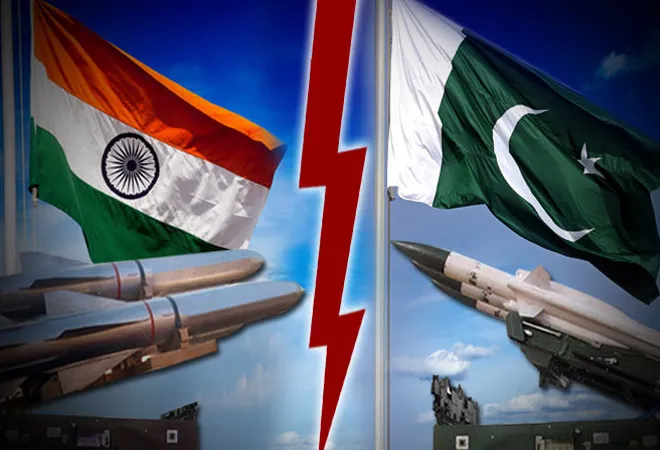
This piece is part of the series,
25 Years Since Pokhran: Reviewing India's Nuclear Odyssey
More than a decade before
Operation Shakti, the strategic landscape in the Indian subcontinent had already been irreversibly altered when, in 1987, Pakistan declared, albeit informally, that it had a
functional nuclear weapon, which it would not hesitate to use if its existence was threatened. The Pokhran-II nuclear tests in 1998 only brought the bombs of India and Pakistan out of the basement, and both countries declared themselves nuclear weapon states. In the process, it upended the power asymmetry between the two countries: While India’s conventional superiority was circumscribed by the nuclear factor, Pakistan’s conventional weakness no longer remained an inhibiting factor for it to indulge in dangerous adventurism against India.
It can, of course, be argued that even pre-1987, Indian diffidence rendered her unable to use its military strength despite Pakistan openly supporting Khalistani secessionists. Post-1987, however, India allowed itself to be boxed in by Pakistan's nuclear status and continued to roll with the blows despite the proxy wars (Punjab and Kashmir) and limited wars (Kargil War) that Pakistan imposed on it. That template only changed in 2019, when
India called Pakistan's bluff with the airstrikes in Balakot. But India’s reluctance, even failure, to climb up the escalation ladder after the Balakot skirmish has, to an extent, restored Pakistan's confidence that it can out-blink India in the game of brinkmanship.
The Pokhran-II nuclear tests in 1998 only brought the bombs of India and Pakistan out of the basement, and both countries declared themselves nuclear weapon states.
Pakistan’s nuclear trump card
The way the nuclear dynamics have played out in the subcontinent, Pakistan has extracted much greater mileage and benefit than India. While India has adopted a more restrained, responsible, and extremely conservative, even conventional, nuclear posture, Pakistan has used the nuclear umbrella very imaginatively and innovatively—for waging proxy wars and limited wars, for avoiding all-out wars, and for extorting economic assistance because no one wanted to see a highly radicalised Islamic country of 200 million people armed with nuclear weapons go under. In many ways, for much of the quarter century since Pakistan became a self-declared nuclear weapon state, deterrence has worked much better for Pakistan than for India, which the latter was unable to achieve in terms of Pakistan’s adventurism. Since the 1980s, Pakistan has successfully taken refuge behind nuclear weapons to export terrorism into India without any fear of retaliation. Less than a year after declaring itself a nuclear weapon state in May 1998, Pakistan initiated the conflict in Kargil.
But Pakistan was not just hiding behind its nukes, it was also signalling its readiness to use them if India dared to retaliate or cross Pakistani red-lines or even came close to defeating Pakistan. Although India has always denied any nuclear stand-off, there have been at least two occasions in the past when Pakistan brought their nukes into play. The first was in
1990 during the Kashmir crisis and then in 1999 during the
Kargil War. Although India has denied that both these crises had become nuclear flashpoints, at around the time the Kargil War had started heating up and Pakistan started facing battlefield reverses, this writer had been approached by a senior cabinet minister very close to Prime Minister Vajpayee and asked about the possibility of Pakistan using nuclear weapons. Clearly, at the uppermost echelons of government, some conversations were taking place about whether or not Pakistan could use nuclear weapons to stave off a humiliating defeat.
Pakistan was not just hiding behind its nukes, it was also signalling its readiness to use them if India dared to retaliate or cross Pakistani red-lines or even came close to defeating Pakistan.
It was only after Pakistan’s Kargil adventurism that India discovered that there was space for military manoeuvres under the nuclear threshold. Until then, Indian strategists had lulled themselves into thinking that wars—limited or otherwise—were ruled out. For many years after Kargil, India kept talking about the possibility of military operations below the nuclear threshold. The much-vaunted
Cold Start doctrine was one of the strategies that Indian military planners came up with. But then the Pakistanis came up with
Full Spectrum Deterrence and included tactical nuclear weapons along with short-range ballistic missiles to counter any Cold Start plans that India might be thinking of initiating.
The Indian response has been to fall back on and reiterate its nuclear posture of overwhelming retaliation against any use of Weapons of Mass Destruction (WMDs) against Indian forces within India or outside Indian territory. While there is nothing wrong with this doctrine, India has had some problems in convincing its adversaries of the credibility of her deterrence. Although in recent years, statements by some Indian policymakers—like former Defence Minister
Manohar Parikkar, former National Security Advisor
SS Menon, and former Chief of Strategic Force Command Lt. Gen. BS Nagal—have hinted at a rethink of the No-First-Use policy, nothing concrete has emerged so far to suggest that there has been a change in the Indian nuclear doctrine.
That Pakistan has found security in its nuclear weapons is a no-brainer. Not only have the nukes protected Pakistan but the converse is also true. For Pakistan, nuclear weapons are a currency of power, something that keeps it relevant even when it can no longer extract rents from its geostrategic location, and in terms of geoeconomics, it is a virtual non-entity bringing nothing worthwhile to the table. Because of this, Pakistan has the
fastest-growing nuclear weapons programme in the world. The fear of Pakistani nukes going loose gives Pakistan leverage and keeps it in play. For its part, Pakistan assiduously conveys the impression that they are crazy enough to use these weapons. Pakistani politicians and even retired generals have made highly irresponsible statements regarding the use of nuclear weapons. It is not just the
Sheikh Rashid who talks of quarter-pound nukes but also someone like former Chief of General Staff Lt. Gen. Shahid Aziz, who in an article in
The Nation on 20 September 2008, wrote about firing “a nuclear warning shot in the Bay of Bengal, across India, demonstrating our circular range capacity” to show that “you don't mess with a nuclear power and get away with it”. Such talk is actually encouraged because it strengthens the ‘irrational enough to use nukes’ impression that Pakistan wants the world, and especially India, to not just believe but internalise.
Pakistani politicians and even retired generals have made highly irresponsible statements regarding the use of nuclear weapons.
Pakistan: Losing its leverage
But the game Pakistan has played for 25 years doesn’t appear to be going its way as it did in the past. India has, of course, called the bluff in Balakot and has injected uncertainty into the equation. Pakistan can no longer be sure of India’s reaction in the event of a terror attack that crosses the threshold of tolerance. Even the West is no longer jumping to Pakistan's rescue at a time when the Pakistani state is withering away. The tough love being shown by the International Monetary Fund (IMF) on the bailout package Pakistan so desperately needs to avoid default is quite uncharacteristic of the Western attitude towards Pakistan. Meanwhile, Pakistan's friends like China and Saudi Arabia are coming to Pakistan's rescue with blank cheques to bail it out. Pakistan's growing weakness is also reflected in the revelations attributed to former Army Chief Qamar Bajwa who told journalists that Pakistan
cannot afford, much less sustain, an open conflict with India. According to some accounts, even after the Balakot skirmishes Pakistan was
keeping fingers crossed that India doesn’t up the ante.
In Pakistan, there is now a real fear that it might be asked to trade its nukes in exchange for preventing an economic meltdown. Pakistan will, of course, resist any ask on its nuclear weapons programme. Chances are that it could even threaten making the nukes fungible to ward off Western pressure. But such a move could only add to Pakistan’s unreliability in the eyes of the world and convince the great powers to de-nuclearise it. Although it appears far-fetched for now, if such a thing was to happen, the strategic balance in the subcontinent would once again swing India’s way. Until then, the tense stand-off, even stasis, that constrains India will remain in force.
Sushant Sareen is Senior Fellow at Observer Research Foundation.
The views expressed above belong to the author(s). ORF research and analyses now available on Telegram! Click here to access our curated content — blogs, longforms and interviews.



 This piece is part of the series,
This piece is part of the series,  PREV
PREV


